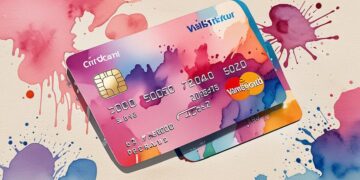Strategies to Manage Credit Card Debt Efficiently

Understanding Credit Card Debt
Managing credit card debt is a critical skill that can significantly impact one’s financial health. When individuals accumulate debt, it often transforms from a mere number into a source of stress and anxiety. By understanding the core components of credit card debt, you can begin to navigate out of overwhelming financial situations.
Interest Rates: One of the most critical aspects is the interest rate applied to your balance. In Canada, credit card interest rates can range from 19.99% to 29.99%, depending on the card and the issuer. This means that a balance left unpaid can quickly balloon, causing monthly payments to feel ineffective. A well-planned strategy can counteract this by targeting high-interest debts first, enabling you to save on potential interest costs.
Minimum Payments: Another common pitfall is the allure of making only the minimum payments. While it might seem manageable, this approach typically leads to a prolonged debt cycle. For instance, if your credit card balance is $5,000 with a 20% interest rate, making just the minimum payment could take over 15 years to pay off, costing you thousands more in interest. Understanding this reality encourages a more proactive approach to payment strategies.
Credit Utilization: Understanding credit utilization is essential for maintaining a healthy credit score. This ratio, calculated by comparing your outstanding balances to your credit limits, should ideally remain below 30%. If you routinely exceed this threshold, your score may suffer, making future loans and credit applications more challenging. Recognizing this important metric can help you prioritize paying down balances to improve your creditworthiness.
Effective Strategies for Debt Management
Now that you comprehend the foundational elements of credit card debt, it is time to delve into effective strategies that can help you regain financial control. Implementing these methods can transform your financial life and alleviate the burden of credit card debt.
- Debt Snowball Method: This method can be a game-changer for those who feel overwhelmed. By focusing on paying off the smallest debts first, you gain a sense of achievement that boosts motivation. For example, if you have several debts of varying amounts, starting with the smallest one can create a psychological momentum towards larger debts.
- Budgeting: Creating a spending plan that prioritizes debt repayment can be incredibly beneficial. Tools such as the 50/30/20 rule—allocating 50% of income to needs, 30% to wants, and 20% to savings and debt repayment—can guide you towards maintaining a balanced financial life. By actively tracking expenditures, you can find areas to cut back and redirect those funds to paying down debt.
- Negotiating Rates: Many are unaware that you can negotiate with creditors for better interest rates. A simple phone call to your credit card issuer can yield favorable results, especially if you have a reliable payment history. Researching competitor rates may provide leverage in your negotiation, allowing you to reduce interest costs and pay off your debt more swiftly.
With diligence and the appropriate strategies, managing credit card debt is not only possible but can also empower you to take charge of your financial journey. Utilizing available resources, such as financial literacy programs or consultations with financial advisors, can further enhance your knowledge and effectiveness in becoming debt-free. By adopting these practical steps, you can transition from feeling burdened to confidently leading your financial life.
DIVE DEEPER: Click here to discover how to apply
Practical Approaches to Tackle Credit Card Debt
While understanding the intricacies of credit card debt is vital, implementing effective strategies is where true progress occurs. To navigate your way out of debt, you must explore practical approaches that can help streamline your financial commitments and alleviate stress. Here are several strategies to consider when managing your credit card debt efficiently:
- Debt Avalanche Method: This strategy focuses on paying off debts with the highest interest rates first. By targeting high-interest balances, you can minimize the overall amount paid in interest over time, ultimately leading to quicker debt elimination. For example, if you have three credit cards with balances of $2,000, $1,500, and $3,000 at interest rates of 20%, 15%, and 25% respectively, allocating extra payments to the $3,000 balance not only saves money but also fast-tracks your debt-free journey.
- Automatic Payments: Setting up automated payments can be a simple yet effective way to ensure that you never miss a due date. Late payments can lead to additional fees and a rise in your interest rates, making managing debt even more challenging. By automating payments, you not only avoid late fees but also establish a reliable routine for consistent debt reduction, significantly improving your financial discipline.
- Downsize Your Lifestyle: Reducing unnecessary expenses is crucial in freeing up cash to allocate towards debt repayment. Consider reevaluating your current lifestyle choices. This can encompass everything from dining out less frequently to canceling subscriptions you rarely use. By identifying non-essential expenditures and downsizing them, you can redirect those funds to accelerate your debt repayment plan.
Credit Counseling: If the burden of credit card debt feels overwhelming, seeking assistance from a nonprofit credit counseling agency can be a beneficial step. These organizations offer free or low-cost advice on budgeting, credit management, and even debt repayment. They can help you create a tailored plan and may negotiate with creditors on your behalf, offering you a clearer path to becoming debt-free.
Employing a combination of these strategies can not only grant you more control over your financial situation but can also build confidence as you witness progress. Additionally, staying informed about new financial products and options available in the Canadian market can yield surprising benefits. Financial institutions often provide debt consolidation loans or balance transfer offers that could lower your interest rates, which may be a lifeline for those struggling with high-interest credit card debt.
The key is to remain proactive and disciplined; by taking these steps consistently, you will gradually dismantle the weight of credit card debt. Familiarizing yourself with these actionable strategies can empower you on your journey toward financial stability and peace of mind.
DISCOVER MORE: Click here for a step-by-step guide!
Innovative Solutions for Credit Card Debt Management
In addition to conventional strategies, exploring innovative solutions can bring a fresh perspective to managing credit card debt effectively. With the rise of technology and new financial products, Canadians have a plethora of options to optimize their repayment journey. Let’s delve into some methods that can assist in tackling your credit card debt more efficiently.
- Balance Transfer Cards: One powerful tool available in Canada is the balance transfer credit card. These cards allow you to transfer high-interest credit card debt to a new card with a significantly lower interest rate, sometimes even 0% for an introductory period. For instance, if you were to shift a $5,000 balance from a 20% APR card to a 0% balance transfer offer, you could save hundreds in interest over the promotional period. However, to maximize this strategy, it is vital to pay off the debt before the interest rate rises after the promotional period ends.
- Utilizing Payment Apps: Technology has revolutionized money management, with numerous payment apps designed to help consumers track their spending and pay down debt effectively. Apps like Mint or YNAB (You Need A Budget) allow you to allocate specific amounts to debt payments while simultaneously keeping an eye on your budget. Utilizing these tools can increase awareness of spending habits and help curb unnecessary expenses, promoting an efficient approach to credit card debt repayment.
- Debt Snowball Method: This popular method complements the Debt Avalanche by employing a psychological approach. Rather than focusing on interest rates, the Debt Snowball method encourages you to pay off your smallest debts first. The satisfaction of eliminating smaller debts can create a motivational momentum to tackle larger debts next. If you have credit card balances of $500, $1,200, and $3,000, starting with the $500 balance can provide a quick win and give you a confidence boost that would encourage continued efforts towards clearing the remaining debt.
Financial Education & Resources: Actively seeking out financial education can also play a crucial role in debt management. Various resources such as webinars, podcasts, and local workshops can equip you with knowledge on budgeting, spending, and debt management strategies. For example, the Government of Canada and community organizations often host free workshops that delve into financial literacy, helping you build essential skills that foster better financial decisions and debt management.
Negotiating with Creditors: Another proactive approach is to negotiate directly with your creditors. This tactic can lead to favorable outcomes like lower interest rates, reduced minimum payments, or even debt forgiveness. Many Canadians may not realize that credit card companies are often open to negotiations, particularly if you explain your financial circumstances. Having such discussions can lead to sustainable financial arrangements that help you regain control over your debt situation.
Remember also, as you manage your credit card debt, that maintaining a solid credit score is essential. Pay attention to your credit utilization ratio; keeping it below 30% not only demonstrates responsible budgeting but can enhance your credit profile, granting you better options in the future, especially if you wish to obtain a loan or mortgage. Use your understanding of these new tools and techniques to devise a tailored debt repayment strategy that encourages both discipline and innovation.
DISCOVER MORE: Click here for a step-by-step guide
Conclusion
Effectively managing credit card debt can often feel like navigating a complex maze, but the strategies outlined in this article serve as essential tools to help Canadians regain financial control. By leveraging resources such as balance transfer cards, you can minimize the burden of high-interest rates, allowing you to direct more of your payments towards the principal balance. Moreover, integrating technology through payment apps provides valuable insights into spending habits, facilitating better budget management while you work on debt repayment.
The psychological boost from the Debt Snowball Method cannot be underestimated. It reinforces positive financial behavior by allowing you to celebrate small wins, ultimately propelling you towards tackling larger liabilities. In your journey, don’t overlook the importance of financial education—resources like local workshops and government initiatives can equip you with the knowledge you need to make informed decisions.
Negotiating with creditors can also lead to beneficial outcomes, reminding us that open communication can pave the way for manageable repayment arrangements. Ultimately, keeping a close eye on your credit utilization ratio is vital; staying below 30% not only helps in maintaining a good credit score but enhances your borrowing prospects for the future.
As you navigate the path to eliminating credit card debt, remember that perseverance, strategic planning, and continuous learning are your allies. By utilizing these strategies and remaining committed to your financial goals, you can transform your relationship with credit and achieve financial freedom. Take the time to reassess your financial landscape, implement these innovative approaches, and discover a brighter, debt-free future.

Linda Carter is a writer and financial expert specializing in personal finance and investments. With extensive experience helping individuals achieve financial stability and make informed decisions, Linda shares her knowledge on the Territorio Deficiente platform. Her goal is to provide readers with practical advice and strategies for financial success and smart investments.





